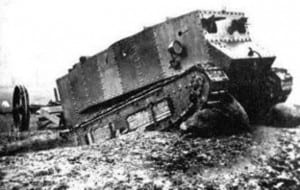Once we had decided on creating the tank as a model, like the monument to be established on the roundabout at Tritton road, we thought about how we were going to make the tank. Several suggestions were tried from hay to cardboard boxes but we decided on using the chairs from the Grandstand because ‘materials themselves have been limited to those that efficiently make the general object form’ ((Morris, R (1993) ‘Anti-Form’ in Morris, R’s Continuous Project Altered Daily: The Writings of Robert Morris London: MIT Press)) the chairs replicated the tank in an easy, but still ambiguous way. Plus, we liked the idea of creating the tank out of objects that were already in and or left in the grandstand because, like the grandstand they had equally been forgotten about .
Since we decided to build the tank out of the chairs, we experimented with looking at the chairs already being there when the audience walked into the room, this worked well because at first the audience had no clue what it was, being just a pile of chairs and some netting set up in a specific way the tank still looked ambiguous enough that the audience would not understand what it was until the performance was underway and the use of soundscapes and dialogue would help them to understand what the sculpture was representing. Alternatively, we looked at simulating the movement of the tank’s caterpillar tracks with the chairs, we thought this image worked well and we decided to build the tank movement wise whilst the audience walked in.
Furthermore, we looked at how this movement was quite repetitive and we believed that each movement we made should be precise and repeatable; this is since the tank was quite mechanical we wanted to replicate that mechanical sense by making the movements accurate and in a form of repetition. We did this by using the whole group to move the chairs where two people would be in perfect sync with each other on each side to make it look like the tracks were moving perfectly; also, we would hold the chairs over the line of the other chairs to make it look neat and mechanical. We decided to add the mantra of the tank force ‘From the blood, through the mud, to the green fields beyond’ here since we believed that the mantra spoke of the goal of the tank and its forces.
Once we had established this much we wanted to look at how we could integrate the tank to the Grandstand, although the tanks were never really used or tested at the grandstand, however, we know there was trench training on the west common ‘Crenelated earthworks just south of the grandstand identify the location of a former training trench from WWI.’ ((Heritage Connection Lincoln West Common online: http://www.heritageconnectlincoln.com/character-area/west-common/64/description (accessed 25th March 2013) )) Additionally we found a picture in the archives on the first tank, Little Willie on the west common,
we can assume here that maybe the tank was brought to the west common to test out on the practice tranches to see whether it would be able to cross the trenches on the warfront. Even though the tank was never really at the Grandstand we still believed it to be a strong part of Lincoln’s history much like the Grandstand that had been forgotten.
